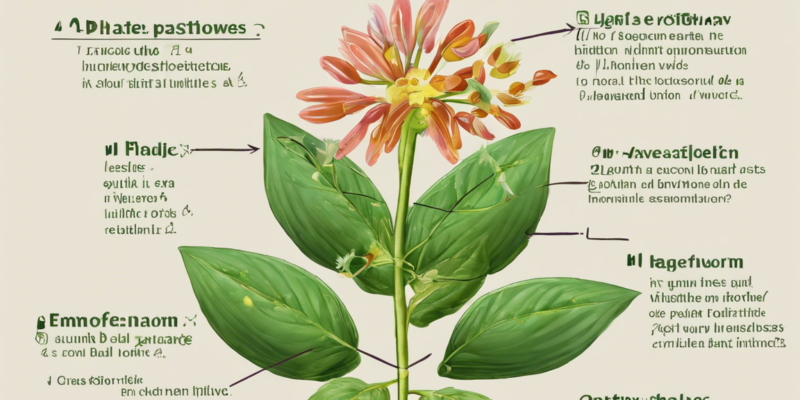Introduction
Plant hormones play a crucial role in the growth and development of plants. These chemical messengers regulate various physiological processes, such as seed germination, growth, flowering, senescence, and responses to environmental stimuli. Identifying which hormones are responsible for specific plant responses is essential for understanding and managing plant growth effectively.
Types of Plant Hormones
There are five main types of plant hormones, also known as phytohormones, that regulate different aspects of plant growth and development:
1. Auxins
- Key functions: Cell elongation, apical dominance, and root growth.
- Identification: High levels of auxins are typically found in the tips of shoots and roots.
- Commercial applications: Used in rooting powder to promote root formation in cuttings.
2. Gibberellins
- Key functions: Stimulate stem elongation, seed germination, and flowering.
- Identification: Gibberellins promote the rapid growth of stems and leaves.
- Commercial applications: Used in agriculture to promote fruit growth and seed germination.
3. Cytokinins
- Key functions: Promote cell division, delay senescence, and counteract apical dominance.
- Identification: Cytokinins are found in growing points, seeds, fruits, and roots.
- Commercial applications: Used in tissue culture to promote shoot formation.
4. Abscisic Acid (ABA)
- Key functions: Regulates seed dormancy and stresses responses.
- Identification: ABA levels increase during drought and other stressful conditions.
- Commercial applications: Used in agriculture to increase drought tolerance.
5. Ethylene
- Key functions: Regulates fruit ripening, abscission, and response to stresses.
- Identification: Ethylene promotes ripening of fruits and abscission of leaves.
- Commercial applications: Used to ripen fruit after harvest.
Methods for Identifying Plant Hormones
- Chromatography:
-
High-performance liquid chromatography (HPLC) and gas chromatography (GC) are commonly used to separate and quantify plant hormones.
-
Biosensors:
-
Enzyme-linked immunosorbent assays (ELISA) and other biosensors provide a rapid and sensitive method for detecting specific plant hormones.
-
Genetic Analysis:
-
Transgenic plants that overexpress or underexpress specific genes can help identify the role of hormones in plants.
-
Radioimmunoassay:
- Radioactive-labeled hormones are used to measure hormone levels in plant tissues accurately.
Factors Affecting Plant Hormone Levels
- Light:
-
Phytochrome and cryptochrome are light-sensitive proteins that regulate the biosynthesis and degradation of plant hormones.
-
Temperature:
-
Cold temperatures can reduce the levels of growth-promoting hormones, such as gibberellins, leading to stunted growth.
-
Water:
-
Water stress can induce the production of ABA, reducing water loss through stomatal closure.
-
Nutrients:
- Nutrient deficiencies can alter the levels of cytokinins and auxins, affecting root growth and nutrient uptake.
FAQs (Frequently Asked Questions)
- How do plant hormones affect plant growth?
-
Plant hormones regulate various physiological processes, such as cell division, elongation, and differentiation, which collectively determine the growth and development of plants.
-
Can plant hormones be manipulated for agricultural purposes?
-
Yes, plant hormones can be used in agriculture to promote growth, increase yields, enhance stress tolerance, and control fruit ripening.
-
Which plant hormone is responsible for root growth?
-
Auxins play a key role in root growth by promoting cell elongation and initiating root formation.
-
How do environmental factors influence plant hormone levels?
-
Environmental factors such as light, temperature, water, and nutrients can modulate the levels of plant hormones, affecting plant growth and responses to stimuli.
-
What is the role of abscisic acid (ABA) in plants?
-
Abscisic acid regulates seed dormancy, water stress responses, and stomatal closure to reduce water loss in plants.
-
Are all plant hormones growth-promoting?
-
No, while hormones like auxins and gibberellins promote growth, hormones like ABA and ethylene are involved in stress responses and ripening, respectively.
-
How can plant hormones be identified in laboratory settings?
-
Plant hormones can be identified using chromatography, biosensors, genetic analysis, and radioimmunoassay techniques to quantify and detect specific hormones.
-
What are some commercial applications of plant hormones?
-
Plant hormones are used in agriculture for rooting powder, tissue culture, fruit ripening, seed germination, and stress tolerance to enhance crop production and quality.
-
Do plant hormones work independently or in synergy with each other?
-
Plant hormones often work synergistically to regulate plant growth and development, with cross-talk between different hormone signaling pathways.
-
Can plant hormone levels vary within different parts of the same plant?
- Yes, plant hormones can vary within different plant tissues and organs based on physiological and environmental conditions, influencing local growth responses.
Conclusion
Identifying and understanding the role of plant hormones is essential for developing effective strategies to promote crop growth, combat environmental stresses, and enhance agricultural sustainability. By utilizing various techniques to quantify and detect plant hormones, researchers and farmers can optimize plant growth and improve crop yields in a sustainable and efficient manner.

